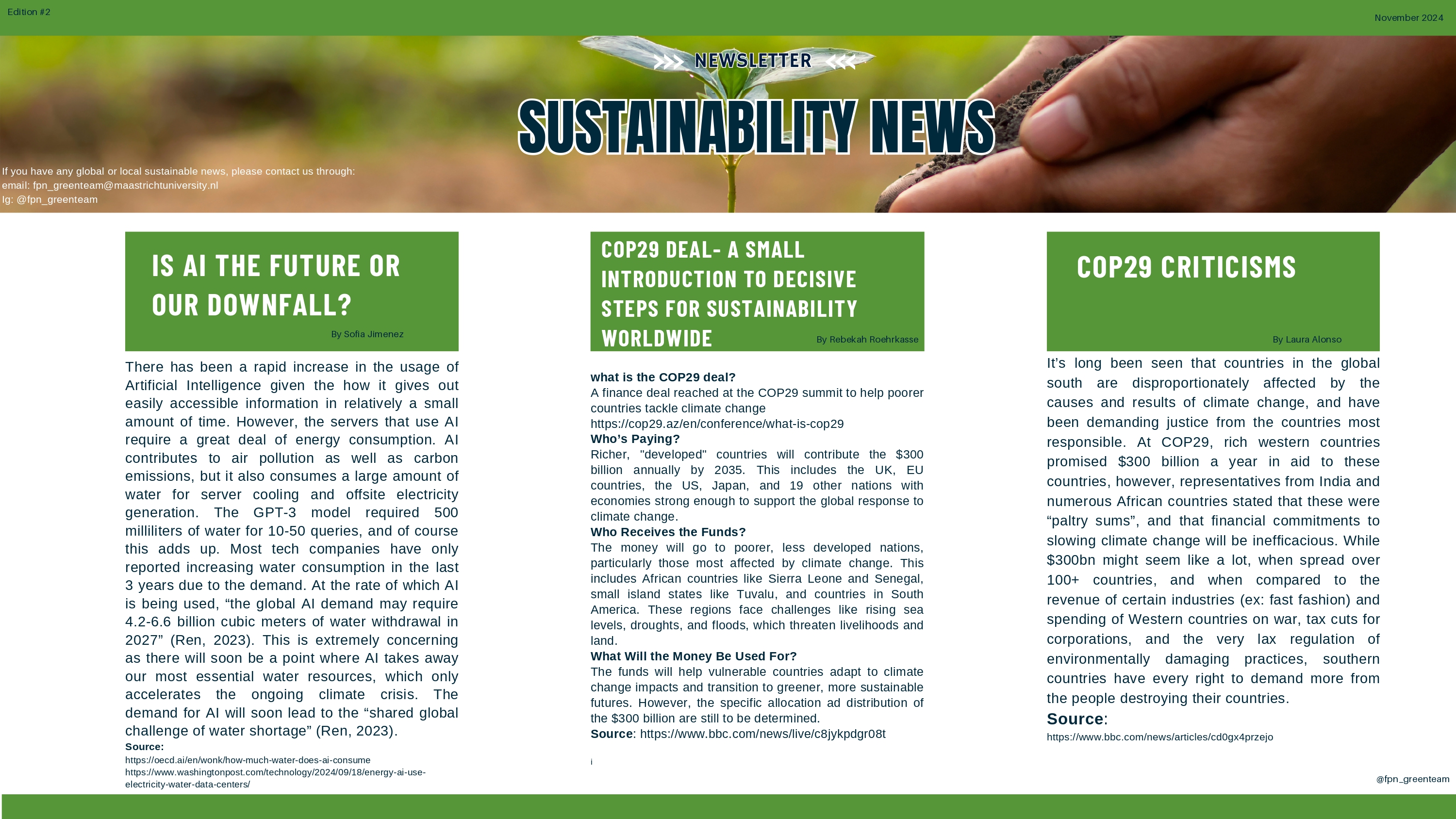Sustainability news from FPN Green Team
FPN Green Team gathered the latest sustainability news, check out their collection!
Is AI the future or our downfall? by Sofia Jimenez
There has been a rapid increase in the usage of Artificial Intelligence given how it provides easily accessible information in a relatively small amount of time. However, the servers that use AI require a great deal of energy consumption. AI contributes to air pollution as well as carbon emissions, but it also consumes a large amount of water for server cooling and offsite electricity generation. The GPT-3 model required 500 milliliters of water for 10–50 queries, and, of course, this adds up. Most tech companies have only reported increasing water consumption in the last three years due to the demand. At the rate at which AI is being used, “the global AI demand may require 4.2–6.6 billion cubic meters of water withdrawal in 2027” (Ren, 2023). This is extremely concerning, as there will soon be a point where AI takes away our most essential water resources, which only accelerates the ongoing climate crisis. The demand for AI will soon lead to the “shared global challenge of water shortage” (Ren, 2023).
Source:
https://oecd.ai/en/wonk/how-much-water-does-ai-consume
https://www.washingtonpost.com/technology/2024/09/18/energy-ai-use-electricity-water-data-centers/
COP29 deal - A small introduction to decisive steps for sustainability worldwide by Rebekah Roehrkasse
What is the COP29 deal?
A finance deal reached at the COP29 summit to help poorer countries tackle climate change (https://cop29.az/en/conference/what-is-cop29).
Who’s paying?
Richer, "developed" countries will contribute $300 billion annually by 2035. This includes the UK, EU countries, the US, Japan, and 19 other nations with economies strong enough to support the global response to climate change.
Who receives the funds?
The money will go to poorer, less developed nations, particularly those most affected by climate change. This includes African countries like Sierra Leone and Senegal, small island states like Tuvalu, and countries in South America. These regions face challenges like rising sea levels, droughts, and floods, which threaten livelihoods and land.
What will the money be used for?
The funds will help vulnerable countries adapt to climate change impacts and transition to greener, more sustainable futures. However, the specific allocation and distribution of the $300 billion are still to be determined.
Source: https://www.bbc.com/news/live/c8jykpdgr08t).
COP29 criticisms by Laura Alonso
It’s long been observed that countries in the global south are disproportionately affected by the causes and results of climate change and have been demanding justice from the countries most responsible. At COP29, rich western countries promised $300 billion a year in aid to these countries; however, representatives from India and numerous African countries stated that these were “paltry sums” and that financial commitments to slowing climate change will be inefficacious. While $300 billion might seem like a lot, when spread over 100+ countries and compared to the revenue of certain industries (e.g., fast fashion) and the spending of Western countries on war, tax cuts for corporations, and the very lax regulation of environmentally damaging practices, southern countries have every right to demand more from the people destroying their countries.

No more fussil fuels? by Sofia Jimenez
Scientists have discovered a way ofconverting CO2 into ethanol which can beused as a sustainable fuel rather than FossilFuel. If you want to understand the sciencebehind this, visit this link. This discovery is not only a sustainablebreakthrough, but a scientific one as well asit shows a likely way to improve theselectivity and capability of reducing CO2into ethanol.This finding is able to aid us inunderstanding more about sustainableenergy solutions and a possible future routefor sustainable and cheap production fromfuels other than fossil fuels.
Source:
https://pubs.rsc.org/en/content/articlelanding/2024/ee/d4ee02308k
Hydrogen powered transport by Rebekah Roehrkasse
In an effort to phase out diesel-poweredtransport vehicles, a ferry in San Franciscopowered by hydrogen began operating inJuly. While this may seem like a small step,it is huge evidence in favor of phasing outfossil-fuel-powered vehicles. In showing the efficiency and ability ofhydrogen-based power, as well as itscomparative abundance and ease ofproduction, it is another way to limit ourdependence on fossil fuels. While phasingout traditional fuel methods is not somethingto be done immediately since it is a complexsocio ecological issue, it is further proof thatsustainable solutions work just as well –ifnot better – than those that harm our world.
Who are the stars in higher education sustainability? by Laura Alonso
Association for the Advancement of Sustainability in HigherEducation (AASHE) recognizes top-performing highereducation institutions for their sustainability efforts. The SCIuses the Sustainability Tracking, Assessment & RatingSystem (STARS) to assess and rank colleges anduniversities based on their sustainability performance invarious areas, including operations, curriculum, andcommunity engagement.
Curriculum:
- Focuses on how sustainability is integrated into academic programs, research opportunities and cocurriclar activites.
- Top performer: Dickinson College (Baccalaurate institutions)
Research:
- Assesses how institutions advance sustainability research, offering funding and support for sustainability related research initiatives.
- Top performer: Université de Sherbrooke (Doctoral institutions)
Campus Engagement:
- Evaluates how well institutions engage students, staff and the wider community in sustainbility efforts, such as sustainability education programs and events.
- Top performer: Thompson Rivers University (Master's institutions)
Source: https://www.aashe.org/wp-content/uploads/2024/09/SCI-2024-Final.pdf